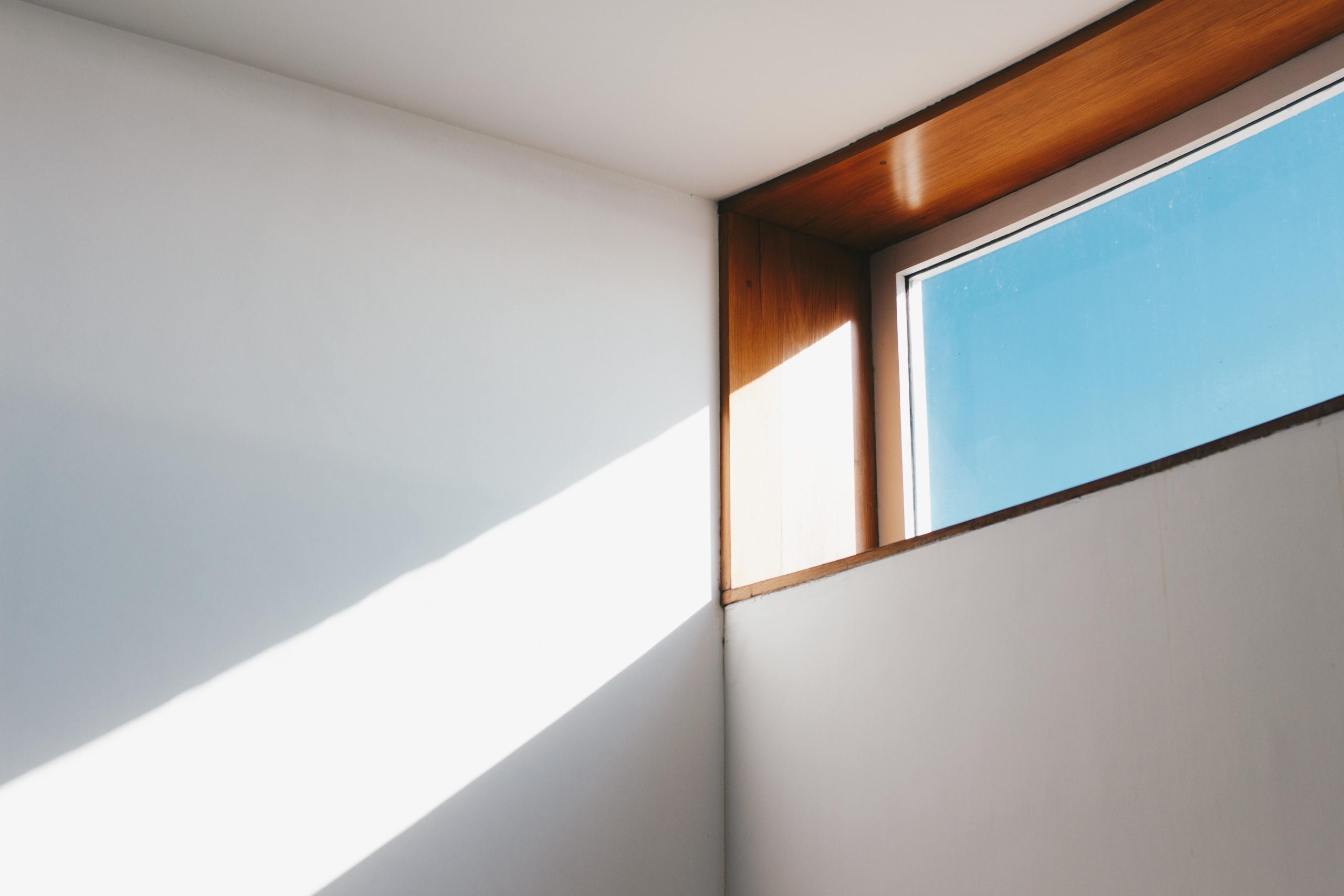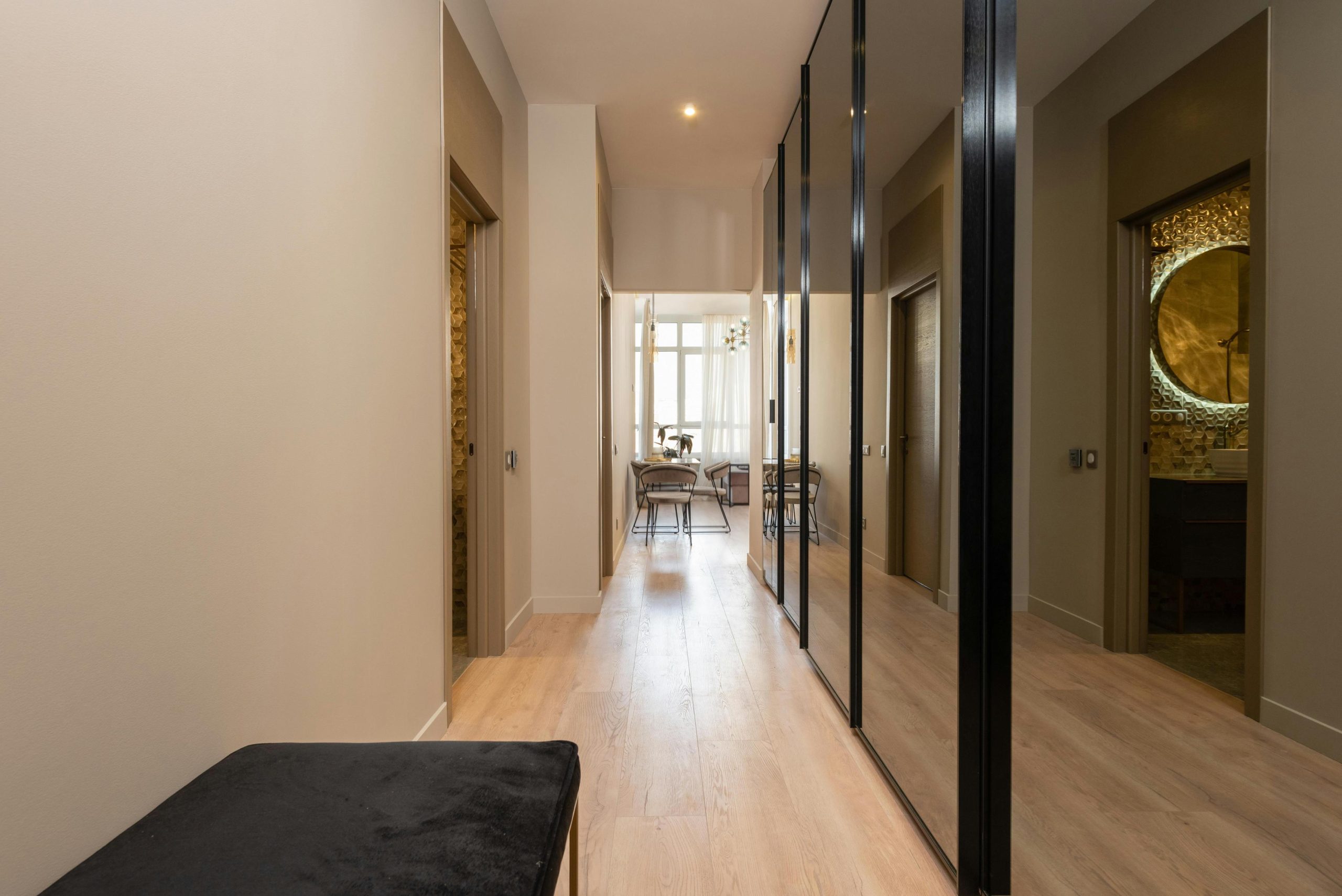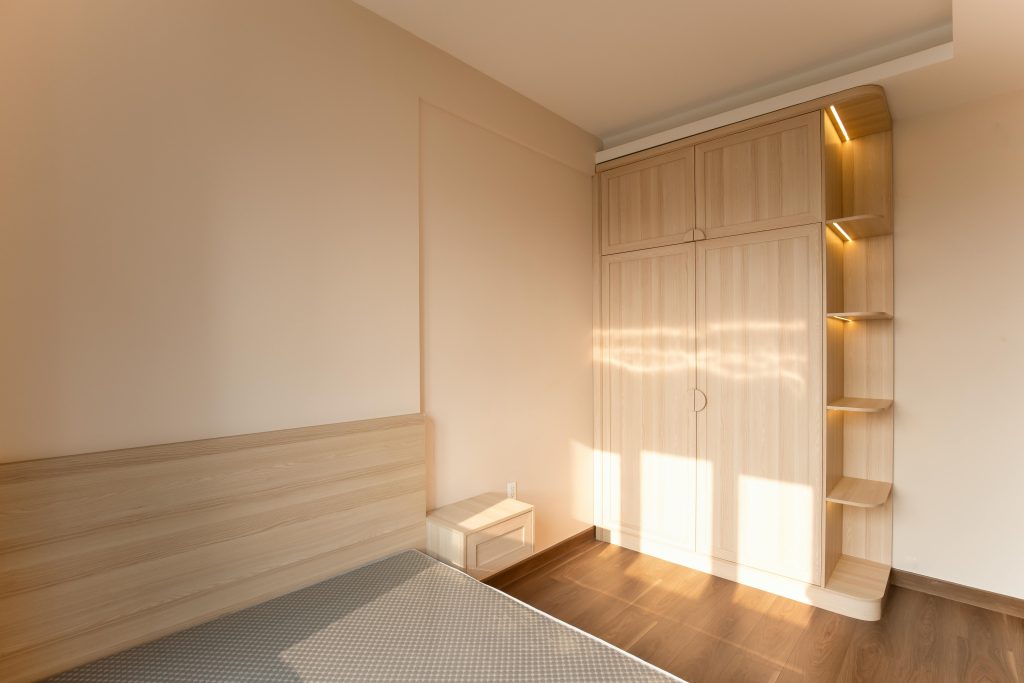Living in a small room doesn’t mean you have to feel cramped. With the right design techniques, you can create a space that feels bright, open, and welcoming. Whether you’re decorating a bedroom, living room, or home office, these practical strategies can make even the tiniest room appear larger.
1. Choose the Right Colors

Color has a huge impact on how spacious a room feels. Light and neutral tones can make walls recede, giving the illusion of more space.
Tips for Choosing Colors:
- Light Neutrals: White, beige, and soft pastels reflect light and open up the space.
- Monochromatic Palette: Using shades of one color makes the room feel cohesive and expansive.
- Accent Walls: A subtle, darker color on one wall can add depth without overwhelming the room.
- Ceiling Colors: Painting the ceiling a lighter shade than the walls can create a feeling of height.
Pro Tip: Avoid dark, heavy colors on all walls—they tend to make a room feel smaller.
2. Maximize Natural Light
Natural light can instantly make a room feel larger and more inviting. Keeping windows unobstructed and using reflective surfaces helps spread light throughout the space.
Ways to Enhance Light:
- Use Sheer Curtains: They let in sunlight while maintaining privacy.
- Mirrors: Position mirrors opposite windows to reflect light and expand the room visually.
- Glass or Acrylic Furniture: Transparent tables or chairs let light pass through, reducing visual clutter.
- Remove Obstructions: Keep windowsills free from large items that block light.
3. Use Strategic Furniture Placement
The right furniture layout is key to maximizing space. Avoid overcrowding the room with oversized pieces and keep traffic flow in mind.
Furniture Tips:
- Multi-functional Pieces: Use storage ottomans, sofa beds, or desks with drawers to reduce clutter.
- Float Furniture: Instead of pushing everything against the walls, allow a small gap between furniture and walls to create depth.
- Choose Low-Profile Furniture: Low beds, couches, and tables give the illusion of taller ceilings.
- Avoid Heavy, Bulky Items: Slimline furniture prevents the room from feeling crowded.
4. Optimize Storage Solutions
Clutter can instantly make a small room feel cramped. Smart storage solutions keep essentials organized without sacrificing space.
Storage Ideas:
- Vertical Storage: Use tall shelves and wall-mounted cabinets.
- Under-Bed Storage: Bins or drawers under beds are perfect for seasonal items or linens.
- Built-In Units: Built-in shelves or seating create storage while keeping the floor open.
- Hidden Storage: Use furniture with compartments to hide everyday items neatly.
5. Use Mirrors and Reflective Surfaces

Mirrors don’t just help with grooming—they’re a powerful tool for creating the illusion of space.
Tips for Using Mirrors:
- Large Wall Mirrors: A single oversized mirror can double the visual space.
- Mirrored Furniture: Coffee tables, dressers, or cabinets with reflective surfaces enhance openness.
- Reflective Décor: Metallic or glass accessories bounce light around the room.
Pro Tip: Position mirrors strategically to reflect light and show the room’s best angles.
6. Layer Your Lighting
Proper lighting creates depth and dimension, making a room feel larger. Combining multiple light sources works better than a single overhead fixture.
Lighting Strategies:
- Ambient Lighting: Use ceiling lights for general illumination.
- Task Lighting: Add desk lamps or reading lights to brighten specific areas.
- Accent Lighting: Wall sconces or LED strips highlight walls and corners.
- Avoid Harsh Shadows: Soft, diffused lighting prevents the room from feeling enclosed.
7. Keep Floors Visible
Floor space is crucial in making a room feel larger. Avoid covering the entire floor with heavy rugs or too many furniture pieces.
Floor Tips:
- Light-Colored Flooring: Wood, laminate, or tiles in light shades expand visual space.
- Minimal Rugs: Use smaller rugs to define areas without breaking up the room.
- Declutter the Floor: Keep furniture and storage off the floor when possible.
8. Choose Minimalist Décor
In small rooms, a minimalist approach can make a big difference. By keeping décor simple and intentional, you prevent the space from feeling cluttered or cramped, while still creating a stylish, inviting environment.
Décor Tips:
- Limit Accessories: Choose a few statement pieces rather than filling every surface. A single vase, framed photo, or decorative object can make an impact without overwhelming the room. Avoid crowding tables, shelves, or mantels with small items.
- Vertical Décor: Hang artwork, mirrors, or shelves vertically to guide the eye upward. This not only creates a sense of height but also keeps the walls functional and visually appealing. Mirrors, in particular, reflect light and give the illusion of more space.
- Consistent Style: Stick to a simple, cohesive design scheme. Choose colors, materials, and patterns that complement each other to create a unified look. Too many contrasting elements can make the room feel chaotic and smaller than it is.
- Hidden Cables: Electronics and cords can create visual clutter. Use cable organizers, raceways, or hidden channels to conceal wires from sight. A clean, wire-free space looks larger and more organized.
- Multipurpose Pieces: Opt for décor that serves multiple functions, like ottomans with storage, foldable furniture, or decorative baskets. This reduces the need for extra furniture while keeping the room tidy.
By carefully curating décor and embracing simplicity, you can make even the tiniest room feel open, airy, and inviting.
9. Use Sliding or Pocket Doors
Traditional swinging doors take up floor space. Sliding or pocket doors free up room and improve flow.
Door Tips:
- Sliding Closet Doors: Free up wall space for shelves or furniture.
- Pocket Doors: Perfect for bathrooms or connecting rooms to maintain open space.
- Glass Doors: Frosted or clear glass doors allow light to travel between rooms.
10. Add Vertical Elements
Drawing the eye upward can dramatically enhance the perception of height in a small room, making it feel more spacious and open. Vertical elements create visual interest without adding bulk, helping you maximize the sense of space.
Vertical Design Ideas:
- Tall Shelves or Bookcases: Choose furniture that reaches toward the ceiling. Tall storage units or bookcases guide the eye upward, creating an illusion of higher ceilings while also adding practical storage.
- Vertical Stripes: Paint walls with vertical stripes or use wallpaper with vertical patterns. This elongates the walls visually, making the room appear taller and more open. Stick to subtle or neutral colors for a sophisticated look, or bold stripes for a fun, modern vibe.
- Hanging Plants: Utilize wall-mounted planters or hanging baskets to bring greenery into the room without taking up valuable floor space. This adds life and dimension while keeping the room uncluttered.
- Curtains from Ceiling to Floor: Mount curtain rods close to the ceiling and let the drapes fall all the way to the floor. This draws attention upward and emphasizes height, even if the window itself is small.
- Tall Lamps or Floor Lamps: Opt for lighting fixtures that extend vertically rather than horizontally. Floor lamps with slim, tall designs can illuminate the space while subtly emphasizing height.
Incorporating vertical elements helps balance proportions, making a small room feel less cramped and more open. Combining these with light colors and clutter-free design further enhances the illusion of space.
11. Incorporate Transparent and Light Materials
Furniture and décor that feel light help avoid a crowded look.
Material Tips:
- Glass Tables: Coffee or dining tables with glass tops feel airy.
- Acrylic Chairs: Clear seating maintains sightlines across the room.
- Open Shelving: Allows light and visibility while providing storage.
- Lightweight Fabrics: Linen or cotton curtains and bedding keep the room fresh.
12. Maintain a Clean, Organized Space
Even the most effective design strategies for making a small room appear larger can be undone by clutter. A clean, organized space feels more open, inviting, and functional. Keeping your room tidy is just as important as choosing the right colors, furniture, or décor.
Organization Tips:
- Daily Tidying: Make it a habit to put items back in their designated places immediately after use. This prevents small messes from accumulating into larger, overwhelming clutter.
- Declutter Regularly: Set aside time monthly or seasonally to remove unnecessary furniture, décor, or belongings that take up space without adding value. Less visual clutter makes the room feel more spacious.
- Use Storage Bins: Group smaller items, like stationery, toys, or electronics, in baskets, boxes, or drawer organizers. Labeling these containers can make it easier to locate items while maintaining a tidy appearance.
- Adopt a Routine: Schedule weekly organization sessions to review what’s in the room, reorganize if needed, and clean surfaces. Consistency ensures the space remains orderly and prevents clutter from building up.
- Maximize Hidden Storage: Make use of under-bed drawers, ottomans with storage, or wall-mounted cabinets to keep belongings out of sight. This keeps floors clear and maintains the illusion of open space.
- Keep Surfaces Minimal: Avoid overcrowding tables, shelves, or countertops. A few carefully selected items create a visually appealing and spacious environment.
By combining consistent cleaning with smart storage strategies, even the smallest room can feel organized, airy, and larger than it actually is.
Final Thoughts
Making a small room look bigger is a combination of strategy, design, and organization. By choosing the right colors, maximizing light, using multifunctional furniture, and maintaining a clutter-free environment, any small room can feel open, airy, and inviting. With these simple and budget-friendly tips, you can transform your space without a major renovation.
